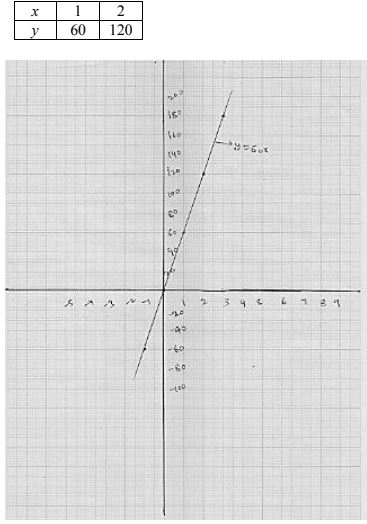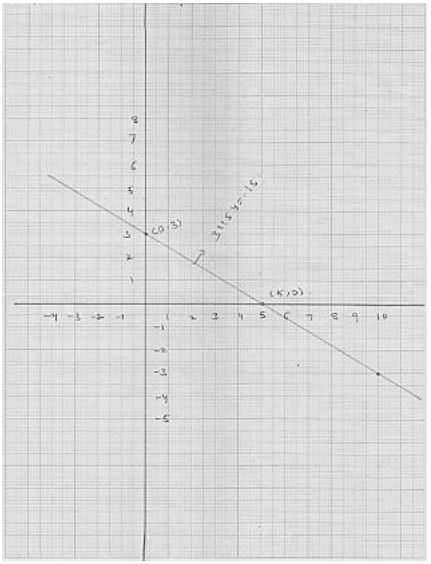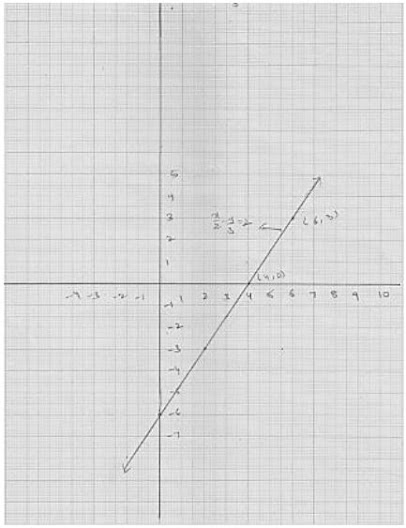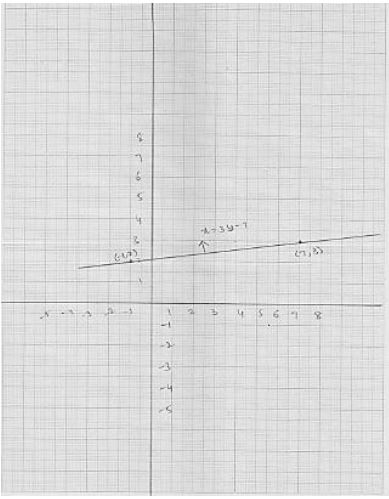Chapter 13 Linear Equations in Two Variables RD Sharma Solutions Exercise 13.3 Class 9 Maths
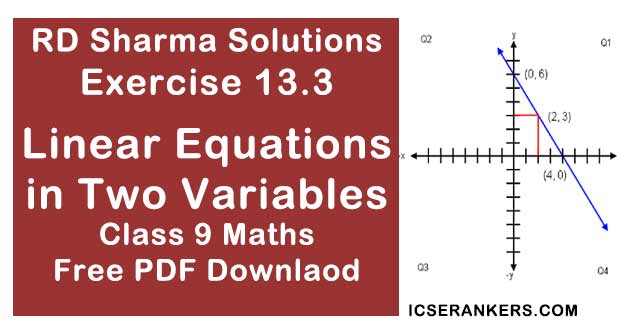
Chapter Name | RD Sharma Chapter 13 Linear Equations in Two Variables Exercise 13.3 |
Book Name | RD Sharma Mathematics for Class 10 |
Other Exercises |
|
Related Study | NCERT Solutions for Class 10 Maths |
Exercise 13.3 Solutions
1. Draw the graph of each of the following linear equation in two variables.
(i) x + y = 4
(ii) x - y = 2
(iii) -x + y = 6
(iv) y = 2x
(v) 3x + 5y = 15
(vi) x/2 - y/3 = 3
(vii) (x - 2)/3 = y - 3
(viii) 2y = -x + 1
Solution
(i) We have x + y = 4
x = 4 - y
Putting y = 0, we get x = 4 - 0 = 4
Putting y = 3, we get x = 4 - 3 = 1
Thus, we get the following table giving the two points on the line represented by the equation x + y = 4
Graph for the equation x + y = 4
(ii) We have,
x - y = 2
x = 2 +y ...(i)
Putting y = 0, we get x = 2 + 0 = 2
Putting y = -2, we get x = 2 - 2 = 0
Thus, we get the following table giving the two points on the line represented by the equation x - y = 2
Graph for the equation x - y = 2
(iii) We have
-x + y = 6
⇒ x = 6 +x
Putting y = -4, we get y = 6 - 4 = 2
Putting x = -3 we get y = 6 - 3 = 3
Thus, we get the following table giving the two points on the line represented by the equation -x + y = 6
Graph for the equation -x + y = 6.
(iv) We have
y = 2x ...(i)
Putting x = 0, we get y = 2 × 0 = 0
Putting x = 1 we get y = 2×1 = 2
Thus, we get the following table giving the two points on the line represented by the equation y =2x
Graph for the equation y = 2x

(v) We have
3x + 5y = 15
3x = 15 - 5y
x = (15- 5y)/3
Putting y = 0, we get x = (15 - 5×0)/3 = 5
Putting y = 3 we get x = 15 - 5× 3)/3 = 0
Thus, we get the following table giving the two points on the line represented by the equation 3x + 5y - 15
Graph for the equation 3x + 5y - 15
(vi) We have
Putting y = -3, we get x = [12 + 2(-3)]/3 = 2
Putting y = 0 we get x = (12 + 0)/3 = 4
Thus, we get the following table giving the two points on the line represented by the equation x/2 - y/3 = 2
Graph for the equation x/2 - y/3 = 3
(vii) We have,
Thus, we get the following table giving the two points on the line represented by the equation (x - 2)/y = y - 3
Graph for the equation (x - 2)/y = y - 3
(viii) We have
2y = -x + 1
⇒ x - 1 = 2y ...(1)
Putting y = 0, we get x = 1 - 2×0 = 1
Putting y = -1, we get x = 1 - 2(-1) = 3
Thus, we have the following table giving the two points on the line represented by the equation
2y = x + 3
2y = -x + 1
Graph for the equation 2y = -x + 1
2. Given the equations of two lines passing through (3, 12). How many more such lines are there, and why ?
Solution
The equation of two lines passing through (3, 12) are
4x - y = 0
3x - y + 3 = 0 ...(i)
There are infinitely many lines passing through (3, 12)
3. A three - wheeler scooter charges Rs 15 for first kilometer and Rs 8 each for every subsequent kilometer. For a distance of x km, an amount of Rs y is paid. Write the linear equation representing the above information.
Solution
Total fare of Rs. y for covering distance of x kilometers is given by
y = 15 + 8(x- 1)
⇒ y = 15 + 8x - 8
⇒ y = 8x + 7
This is the required linear equation for the given information.
4. A lending library has a fixed charge for the first three days and an additional charge for each day thereafter. Aarushi paid Rs 27 for a book kept for seven days. If fixed charges are Rs x and per day charges are Rs y. Write the linear equation representing the above information.
Solution
Total charges paid by Aarushi is given by
27 = x + 4y
⇒ x + 4y = 27
This is the required linear equation for the given information.
5. A number is 27 more than the number obtained by reversing its digits. If its unit's and ten's digit are x and y respectively, write the linear equation representing the above statement.
Solution
Total original number is 10y + x
The new number is obtained after reversing the order of digits is 10x + y
According to question
⇒ 10y + x = 10x + y + 27
⇒ 9y - 9x = 27
⇒ y -x = 3
⇒ x - y + 3 = 0
This is the required linear equation for the given information.
6. The sum of a two digit number and the number obtained by reversing the order of its digits is 121. If units and ten's digit of the number are x and y respectively then write the linear equation representing the above statement.
Solution
Total original number is 10y + x
The new number is obtained after reversing the order of digits is (10x y)
According to problem
(10y +x) + (10x +y) = 121
⇒ 11x + 11y = 121
⇒ 11(x + y) = 121
⇒ x + y = 11
Thus is the required linear equation for the given information.
7. Plot the points (3, 5) and (-1, 3) on a graph paper and verify that the straight line passing through these points also passes through the point (1, 4).
Solution
The points given in the graph :
It is clear from the graph the straight lines passes through these points also pass a through (1, 4).
8. From the choices given below, choose the equation whose graph is given in Fig. below.
(i) y = x
(ii) x + y = 0
(iii) y = 2x
(iv) 2 + 3y = 7x
[Hint : Clearly, (-1, 1) and (1, - 1) satisfy the equation x + y = 0 ]
Solution
Clearly (-1, 1) and (1, -1) satisfy the equation x + y = 0
∴ The equation whose graph is given by x + y = 0
9. From the choices given below, choose the equation whose graph is given in fig. below.
(i) y = x + 2
(ii) y = x - 2
(iii) y = -x + 2
(iv) x + 2y = 6
[Hint : Clearly, (2, 0) and (-1, 3) satisfy the equation y = -x +2 ]
Solution
Clearly (2, 0) and (-1, 3) satisfy the equation y = -x + 2
∴ The equation whose graph is given by y = -x + 2
10. If the point (2, -2) lies on the graph of the linear equation 5x + ky = 4 , find the value of k.
Solution
It is given that (2, -2) is a solution of the equation 5x + ky = 4
∴ 5 × 2 + k ×(-2) = 4
⇒ 10 - 2k = 4
⇒ -2k = 4 - 10
⇒ -2k -6
⇒ k = 3
11. Draw the graph of the equation 2x + 3y = 12. From the graph, find the coordinates of the point:
(i) whose y-coordinates is 3.
(ii) whose x - coordinate is -3.
Solution
Graph of the equation 2x + 3y = 12.
We have,
2x + 3y = 12
⇒ 2x = 12 - 3y
⇒ x = (12 - 3y)/2
Putting y = 2, we get x = (12 -3×2)/2 = 3
Putting y = -4, we get x = (12 - 3×4)/2 = 0
Thus, (3, 0) and (0, 4) are two points on the line 2x + 3y = 12
The graph of line represents by the equation 2x + 3y = 12
|
X |
0 |
3 |
|
Y |
4 |
2 |
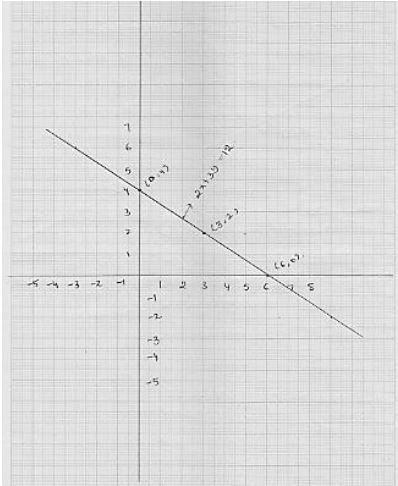
(ii) -x + 4y = 8
(iii) 2x + y = 6
(iv) 3x + 2y + 6 = 0
⇒ 3(2x - y) = 12
⇒ 2x - y = 4
⇒ 2x - 4 = y
⇒ y = 2x - 4 ...(i)
Putting x = 0 in (i), we get y = -4
Putting x = 2 in (i), we get y = 0
Thus, we obtain the following table giving coordinates of two points on the line represented by the equation 6x - 3y = 12.
The graph of the line 6x - 3y = 12

⇒ 4y - 8 = x
⇒x = 4y = 8
Putting y = 1 in (i), we get x = 4 × 1 - 8 = -4
Putting y = 2 in (i), we get x = 4 ×2 - 8 = 0
Thus, we obtain the following table giving coordinates of two points on the line represented by the equation -x + 4y = -8
Graph of the equation -x + 4y = 8

2x + y = 6
⇒ y = 6- 2x ...(i)
Putting x = 3 in (i), we get y = 6 = 2 × 3 = 0
Putting x = 4 in (i), we get y = 6 - 2× 4 = -2
Thus, we obtain the following table giving coordinate of two points on the line represented by the equation 2x + y = 6
Graph of the equation 2x + y = 6

⇒ 2y = -6 - 3x
⇒ y = (-6 - 3x)/2
Putting x = -2 in (i), we get x = [6 - 3(-2)]/2 = 0
Putting x = -4 in (i), we get y = [6 - 3(-4)]/2 = 3
Thus, we obtain the following table giving coordinates of two points on the line represented by the equation 3x + 2y + 6 = 0
Graph of the equation 3x - 2y + 6 = 0

y = 6 - 2x ...(i)
Putting x = 3 in (i), we get y = 6 - 2 × 3 = 0
Putting x = 0 in (i), we get y = 6 - 2 × 0 = 6
Thus, we obtained the following table giving coordinates of two points on the line represented by the equation 2x + y = 6
|
X |
3 |
0 |
|
Y |
0 |
6 |
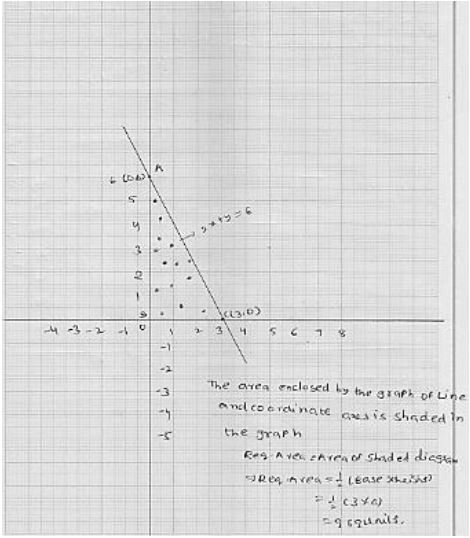
⇒ 4x + 3y = 12
⇒ 4x = 12 -3y
⇒ x = (12 - 3y)/4
Putting y = 0 in (i), we get x = (12 - 3×0)/4 = 3
Thus, we obtained the following table giving coordinate of two points on the line represents by the equation x/3 + y/4 = 1.
X | 0 | 3 |
Y | 4 | 0 |

Putting x = 0, we get y = 0
Putting x = 2, we get y = 2
Putting x = 2, we get y = -12
|
X |
0 |
2 |
-2 |
|
Y |
0 |
2 |
2 |

Putting x = 0, we get y = 2 ...(ii)
Putting x = 1, we get y = 3
Putting x = -1, we get y = 3
X | 0 | 1 | 1 |
Y | 2 | 3 | 3 |
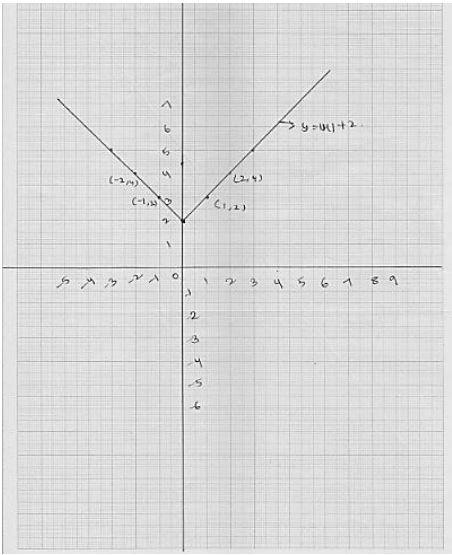
Find the coordinates of the vertices of the triangle formed by the two straight lines and the y - axis. Also, find the area of the triangle.
We have
⇒ x = (12 - 3y)/2
Putting y = 4, we get x = (12 - 3× 4)/2 = 0
Putting y = 2, we get x = (12 - 3×2)/2 = 3
Thus, we have the following table for the P table for the points on the line 2x + 3y = 12
X | 0 | 3 |
Y | 4 | 2 |
we obtain graph of the equation.
Thus, we have the following table for the points the line x - y = 1
X | 1 | 0 |
Y | 0 | -1 |

The graph of time 2x + 3y = 12 intersect with y - axis at B(0, 4) and the graph of the line x - y = 1 intersect with y - axis at C(0, -1).
So, the vertices of the triangle formed by thee two straight lines and y - axis are A(3, 2) and B(0, 4) and C(0, -1)
Now,

⇒ 4x - 3y = 4
Putting y = 0, we get x = (3 × 0 - 4)/4 = - 1
Putting y = 4, we get x = (3 × 4 - 4)/ 4 = 2
Thus, we have the following table for the p table for the points on the line 4x - 3y + 4 = 0
X | -1 | 2 |
Y | 0 | 4 |
⇒ 4x = 20 - 3y
Putting y = 4, we get x = (20 - 3 × 4)/4 = 2.
Thus, we have the following table for the p table for the points on the line 4x - 3y - 20 = 0
X | 0 | 2 |
Y | 0 | 4 |

Clearly, two lines intersect at A(2, 4)
The graph of the lines 4x - 3y + 4 = 0 and 4x + 3y - 20 = 0 intersect with y - axis at a + b(-1, 0) and c(5, 0) respectively

⇒ 3x = 12 - 4y
⇒ 3x = (12 - 4y)/3

⇒ 7x - 49 = y - 7
⇒ 7x - 42 = y ...(i)
It is also given that after three years from now Ravish shall be three times a sold as her daughter
Now, y = 7x - 42 [using (i)]
Putting x = 5, we get y = 7× 5 - 42 = -7
Thus, we have following table for the points on the
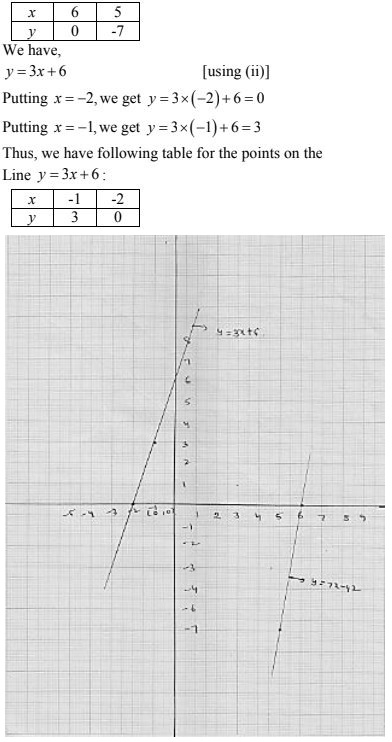
(i) 2(1/2) Hours
We know that speed= distance/speed
⇒ y = 60x
Putting x = 1, we get y = 60
Putting x = 2, we get y = 120
Thus, we have the following table for the points on the line y = 60x
